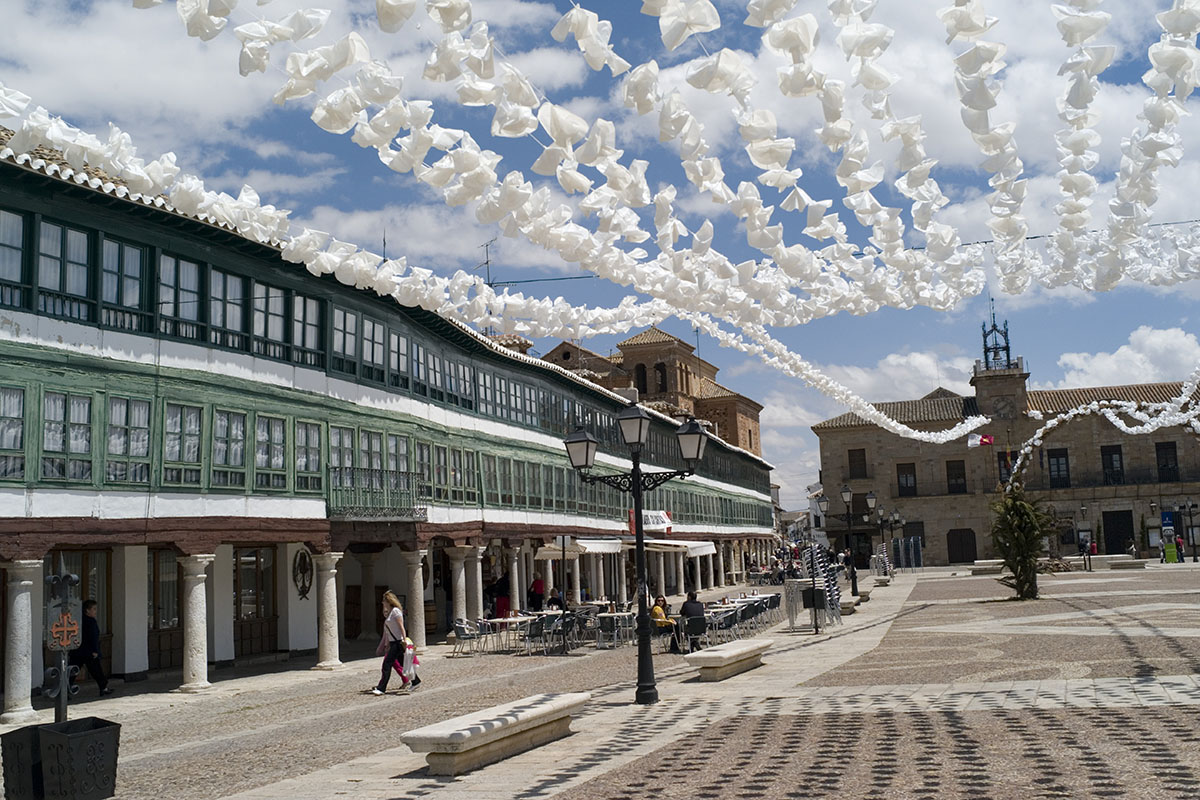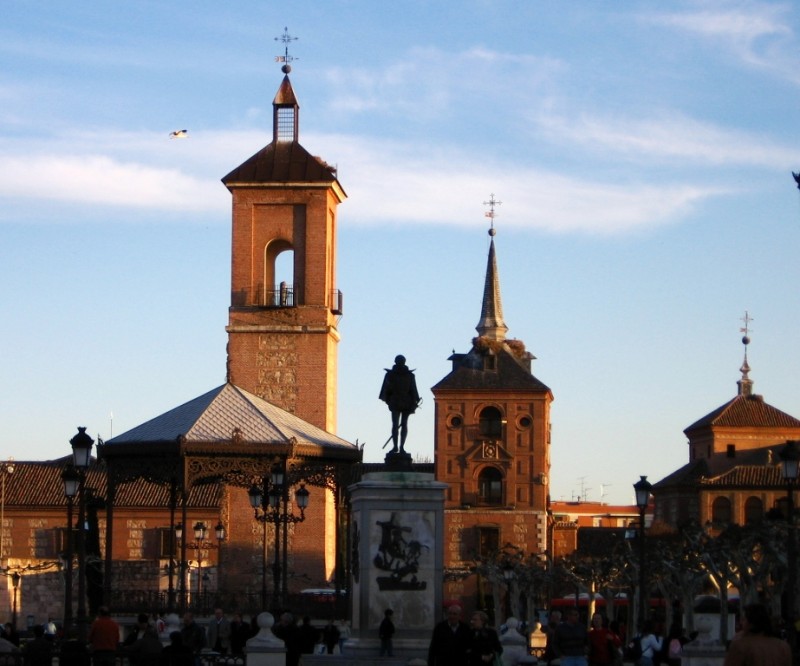Be there or be square: 8 of Spain’s best plazas
Bullfights, sangria, paella… So many of the things that, to the uninitiated, epitomise Spain’s culture are actually outdated, tourist traps, or limited to just one of the country’s regions.
But there’s one Spanish heavyweight that fully deserves to be celebrated alongside tortilla de patatas, siestas, and Rosalía on the list of the best things ever to emerge from the Iberian Peninsula. A cultural icon with adoring fans all over the country, from the hills of Asturias to sunny southern seaside towns, and in every metropolis and pueblo in between. I’m talking, of course, about the Spanish plaza.
Some squares slip under the radar of anyone who doesn’t know to seek them out. Some are the perfect place for a protest; some are best suited for locals and blow-ins alike to meet for a beer, a gossip, and a people-watching session. Others have become tourist attractions in their own right, be it thanks to their historical significance or just because they make for an awesome photo op.
Whatever you’re after on your next day trip or weekend away, here’s a list of eight of Spain’s best plazas you should make sure not to miss.
1. Plaza Mayor, Almagro

Green and gorgeous, this recently-restored medieval plaza is one of the country’s favourites – and provided a beautiful backdrop for post-class coffees or cañas back when I worked in a nearby school.
Thanks to its flowers and fountains, Almagro’s Plaza Mayor regularly features on lists of Spain’s top ten most beautiful squares, and I monitor its progress like a proud manchego mother, rejoicing when it moves up a spot and sulking when it’s relegated.
Make sure to try the local delicacy of pickled berenjenas at any one of the tapas bars dotted around the plaza – they were slightly too green and bitter for my liking, but they’re a regional favourite and sobre gustos no hay nada escrito, so you might enjoy them.
What’s more, Almagro is home to the annual Festival Internacional de Teatro Clásico, and tucked away next to the square’s shops and restaurants is the entrance to the corral de comedias, a 17th-century playhouse and hidden gem of a tourist attraction which is more than worth the €3 entrance fee.
2. Plaza Dos de Mayo, Madrid

It’s no surprise that Spain’s capital has a square for every taste – Plaza de España (gone but not forgotten), colourful Chueca, floral Plaza de la Villa, Santa Ana for the literature lovers, and Plaza Mayor if you’re a fan of Baroque architecture and, eh, multi-coloured goats.
But a particular stand-out is Dos de Mayo, just ten minutes’ walk from Sol.
This plaza is a crucial one for history lovers: it marks a key date in the Comunidad de Madrid’s calendar, when the people of Madrid rebelled against occupying French troops on 2nd May 1808.
Annual street parties marking the uprising liven up the already-bustling barrio of Malasaña, but this square is worth a visit at any time of the year – it boasts playparks for the peques, a weekly vintage and craft market, and plenty of places to stop for a snack or drink (Pizzería Maravillas is a stand-out).
3. Plaza Mayor, Ciudad Real

Source: Image by © Rob Cousins/robertharding/Corbis
The small city of Ciudad Real is often overshadowed by its province’s more picturesque pueblos, but I maintain that my former hometown’s central square is still worth a visit, if only for its Reloj Carrillón – a huge clock from which life-size figurines of Cervantes, Don Quijote and Sancho Panza emerge to the sound of bells chiming at regular intervals throughout the day and night.
This manchego capital isn’t known for being the most Instagrammable of towns, but it has a plaza that pays artistic homage to the stars of its regions, friendly locals, and more tapas bars than you could shake a stick at. What more do you need, really?
4. Plaza del Taller, Santiago de Compostela
Whether you’ve trekked part of the epic Camino de Santiago or are just up north on a pilgrimage for Galician pulpo (guilty), this isn’t a square to be missed. Plaza del Taller – or, to use its gallego name, Praza do Obradoiro – is a spot in the rainy, atmospheric Galician capital.
Located to the west of Santiago’s enchanting casco viejo, this square marks the end of the road for pilgrims who’ve walked St James’ Way, and it provides peak people-watching opportunities – I’d challenge anyone to watch pilgrims rejoicing at the completion of their journey without getting emotional. For travellers holy or secular, the plaza’s architecture, sheer size, and its magical (and traffic-free) atmosphere are definitely worth a trip next puente.
This square is also home to the beautiful, baroque Catedral de Santiago de Compostela, where hikers participate in the post-walk ritual of the abrazo al Apóstol Santiago – a tradition that was temporarily outlawed in 2009 after an influenza outbreak. Maybe stick to a quick high-five if you’re a germaphobe.
5. Plaza de Cervantes, Alcalá de Henares

Cons of Alcalá’s most famous public space: the storks (if, like me, you’re a wimp who’s scared of birds). Pros: literally everything else.
This square pays homage Alcalá’s most famous son: the writer Miguel de Cervantes, who was born in the university city in 1547. The city’s central plaza hosts regular literary and cultural events in his honour, such as the annual Mercado Cervantino.
Plaza de Cervantes also bridges two of the city’s most significant streets: the newly pedestrianized Calle de Libreros, and the Calle Mayor. On the latter street, which is the former hub of the medieval Jewish Quarter, you can find the Museo Casa Natal de Cervantes and the city’s most photogenic bench, featuring bronze statues of Cervantes’ most famous characters.
Have a stroll through the surrounding area – don’t think about leaving without taking in the university’s impressive façade – and you’ll understand exactly why Alcalá has been declared a UNESCO World Heritage Site.
Also read: 7 Reasons why Alcalá de Henares is worth more than a day trip from Madrid
6. Plaza de España, Sevilla

Oh, this one’s gorgeous. Constructed in 1929, the Andalusian capital’s Plaza de España is practically a newborn compared with some of the old-timers on this list, but in terms of impact and beauty, it can definitely give the classics a run for their money.
This plaza’s most famous feature is the breath-taking range of multicoloured tiled alcoves, which depict almost every province in Spain. Photos can’t do them justice, but even the briefest of trawls through Google Images will show you exactly why the good people of TripAdvisor voted it the world’s segundo lugar más spectacular del mundo.
Film buffs (not me) might recognise this square from movies like Lawrence of Arabia and the Star Wars franchise, while Instagram lovers will be more familiar with its pretty canals, where you can row your boat for just €6. The Plaza de España is also located in the Parque de María Luisa – a beautiful spot to seek out the shade during the infamously hot Sevillian summers.
7. Plaza Mayor, Salamanca

Golden hour enthusiasts, this one’s for you. Salamanca is known far and wide as one of the most gorgeous places in Spain, and its main plaza is no exception. Built between 1729 and 1755, the sandstone square still shines – and if you ever want to hear several hundred people simultaneously say ‘Ahhhhh!’, make sure you’re standing in the centre when its buildings get illuminated at dusk.
The plaza is adorned with medallions bearing big names from Spain’s history. In fact, until it was removed in 2017 under the Historical Memory Law, you could even spot Franco’s defaced, paint-splattered face lurking beneath a plastic bag in the corner.
Salamanca’s Plaza Mayor also has plenty of bars and restaurants where you can sample the city’s distinctly un-spicy, but delicious, take on patatas bravas after you’ve finished frogspotting at the nearby Universidad de Salamanca.
Speaking of which, try to time your trip for December, when the legendary Nochevieja Universitaria sees the Plaza Mayor packed with thousands of students downing their drink and midnight grapes before heading home to their pueblos for Christmas. Or, if you prefer hot drinks to alcoholic ones, walk south from the plaza for ten minutes to the café of the Casa Lis art deco museum, where you’ll find the world’s tastiest cup of hot chocolate and the only glass ceiling that’s not for smashing.
8. Esta Es Una Plaza, Madrid

This urban oasis is a bit different – and for that reason, it might be my favourite plaza ever. Esta Es Una Plaza is a neighbourhood initiative designed to tackle the lack of green space available in the busy Madrid barrio of Lavapiés, and has gone from strength to strength since its creation in 2008, thanks to the group of dedicated volunteers who work hard on maintenance and upkeep.
According to its website, the community-run public space focuses heavily on community building and promoting cohesion between social groups, regardless of nationality or religion, and over time the plaza has transformed into a cultural hub which promotes ecology, self-sufficiency, literacy, culture and sports.
It mightn’t represent the same flashy, tourist fodder as some of the more high-profile squares on our list, and it’s unlikely you’ll see it be flogged on a postcard any time soon. But if plazas are meant to promote harmony, facilitate socializing, and provide an insight into the beating heart of its local community, then Esta Es Una Plaza is definitely a dark horse.
By Emer O’Toole (IG: @_emerotoole)
Would you add any other of Spain’s best plazas to this list? Let us know!










